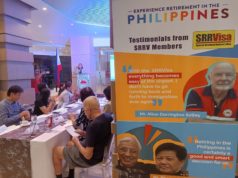Scraped mountain at the site of Donggwang’s Sun Valley Leisure Community. Photo by Ric Gonzales
CLARK FREEPORT – The Clark Development Corp. (CDC) defended the $400-million Donggwang Sunvalley Lei-sure Community (DSLC) here, saying the Korean firm’s project is safe and more than 100 non-endemic trees were cut at the project’s “generally grassland” area.
The CDC said the Donggwang Clark Corp. (DCC), developer of the 304-hectare DSLC, was cited by Department Environment of Natural Resources (DENR) for “strict compliance” to environmental laws in connection with the nearly finished erosion mitigating project.
“Of course, it is bald because the construction is going on. This is small or just one mountain is involved,” said CDC Environment Management Department (EMD) Manager Juan Miguel B. Fuentes in a phone interview on Wednesday.
He was asked about the eroded portion of the mountain in Clark which is part of the DCC’s leisure and tourism project.
Fuentes cited as an example the P27-billion Subic-Clark-Tarlac Expressway (SCETx) project when asked further about the portion cut by the DCC for its 36-hole golf course.
He said “bigger and more” mountains had been cut to allow the completion of the 94-kilometer SCTEx.
More importantly, Fuentes said, the DCC project “similar to the SCTEx is safe based on engineering studies” citing its remaining “intact” despite the many typhoons and strong rains that hit the area.
Fuentes, who was asked by CDC acting President and CEO Eduardo Oban Jr. to answer questions raised by Pampanga-based environmentalists, disclosed that 128 small Japanese and eucalyptus trees were cut.
He added both species are not endemic in the Philippines and were planted at the site by the former locator, True North Golf Course.
In December 3, 2010, the CDC leased the 304 hectares to the DCC, including the area earlier developed by True North as golf course starting in 1997.
Fuentes assured the public that “no more trees” will be cut in the area developed by the South Korean firm whose initial investment was reported to be $153 million.
In earlier statements released by the CDC public relations department, Fuentes said the erosion mitigating measures at the construction site involved the bulldozing of rocks at the tip of a nearby mountain, which had a “risky overhang.”
To remove the overhang, the firm’s engineers used the “gravity method,” an engineering methodology used to scrape and push small portions of the mountain and let the rocks fall to seek a stable slope or angle of repose.
Once the overhang is eliminated, Fuentes said the area will be treated to combine hydro seeding and coconet reinforcement to prevent soil erosion.
He also downplayed apprehensions that trees were destroyed during the construction phase.
”The construction site is on top of a rock formation where it is impossible for trees to grow,” Fuentes clarified.
This was confirmed by Environment Management Bureau (EMB) Environmental Management Officer Elisa Dimaliwat, who said DCC had complied with environmental laws and guidelines.
“Donggwang Clark Project has an Environmental Compliance Certificate (ECC) issued by the EMB-Central Office last May 5, 2011, and has an active Multipartite Monitoring Team (MMT), which has been regularly meeting, latest of which was held only last July 6,” Dimaliwat said.
She added that “Donggwang also has a full time Pollution Control Officer (PCO) accredited by EMB as required by DENR laws.”
The CDC also announced earlier that erosion-mitigating measures being utilized at the construction site of DCC’s tourism estate is 80 percent completed.
Fuentes said the engineering methodologies employed by the South Korean firm’s team had been cited by the DENR’s EMB.
According to Fuentes, EMB Regional Director Lormelyn Claudio said she was impressed with the strict compliance of DCC to environmental laws.
Claudio said the South Korean firm had secured and complied with all the necessary permits required in the construction of the DCC’s tourism estate, the CDC disclosed.
Fuentes also denied claims of residents of Sapang Bato, Angeles City that the “water with brown sand” that hit the village came from the DCC’s construction site, particularly the golf course.
He said the “brown water” could not be attributed to DCC because the project site “only drains out to the Sacobia River and Dolores Creek in Mabalacat City.
Fuentes said the brown water at Sapang Bato, could have come from the banks which eroded during the rainy season.
In March this year, DCC officials and CDC executives led the inauguration of the projects Tower 1 and 2. This was followed by the ground-breaking rites for the construction a $200-million golf clubhouse.
The DCC, the Philippine subsidiary of Donggwang Construction, expects to complete the world class estate in 2016.
The project consists of a 36-hole golf course, clubhouse, 330-room condominium, water park, spa and gymnasium, ecopark, business center, international school, golf academy and driving range, medical clinic and drug store, hotel, casino, 500-unit villa, and shopping arcade.
Once completed, the Donggwang project, CDC said would employ more than 2,000 workers and expand tourism and economic activities in Central Luzon. It added that Donggwang Construction, one of South Korea’s largest construction companies, has total assets of 1.2 trillion won or around $945 million.
Collateral and PR materials listed Donggwang Construction as owner and operator of Sorak Sun Valley Country Club, Dongwon Sun Valley Country Club, Iljuk Sun Valley Country Club, and Japan-based Yabe Country Club.




